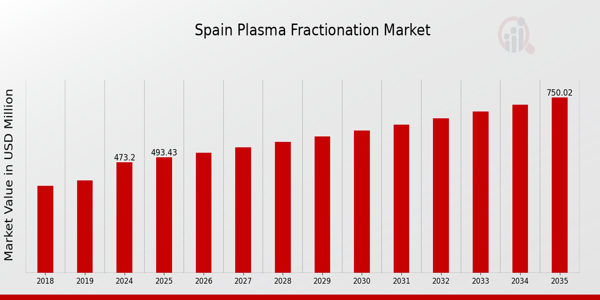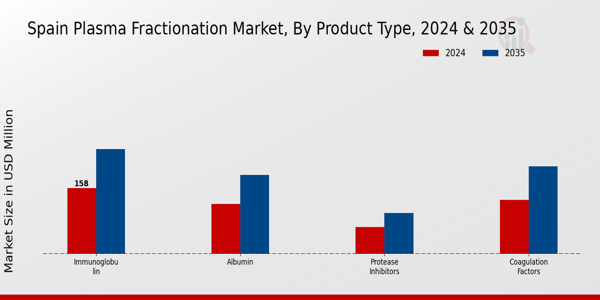Spain Plasma Fractionation Market Overview
As per MRFR analysis, the Spain Plasma Fractionation Market Size was estimated at 454 (USD Million) in 2024.The Spain Plasma Fractionation Market Industry is expected to grow from 473.2(USD Million) in 2025 to 750 (USD Million) by 2035. The Spain Plasma Fractionation Market CAGR (growth rate) is expected to be around 4.276% during the forecast period (2025 - 2035).
Key Spain Plasma Fractionation Market Trends Highlighted
The Spain Plasma Fractionation Market is experiencing notable changes driven by an increasing demand for immunoglobulins and clotting factor concentrates. Spanish health authorities are progressively emphasizing the importance of plasma-derived therapies, leading to greater investment in research and development. This growth is partly fueled by a rise in the prevalence of autoimmune diseases and bleeding disorders within the population, prompting the need for more effective treatments. Additionally, the Spanish government’s strong focus on enhancing healthcare infrastructure and promoting self-sufficiency in blood products is shaping the market landscape.
Opportunities to be captured in this market include the potential to expand local plasma collection centers. There is a push for increased awareness and education about the benefits of plasma donation, which could bolster supply. Furthermore, as Spain strengthens its regulatory framework, companies have the chance to differentiate themselves through compliance, quality assurance, and innovation in product development. Trends in recent times reveal a shift towards advanced technologies in plasma fractionation, such as the utilization of high-throughput systems that improve efficiency while maintaining safety standards.
The ongoing collaboration between public healthcare systems and private entities is also noteworthy, paving the way for partnerships that can drive growth in this sector.Moreover, Spain's robust clinical research programs are generating valuable data, fostering the development of new therapies that can further expand the applications of plasma derivatives. Overall, the plasma fractionation market in Spain is poised for growth, driven by these dynamic trends and a conducive regulatory environment.

Source: Primary Research, Secondary Research, Market Research Future Database and Analyst Review
Spain Plasma Fractionation Market Drivers
Increasing Demand for Immunoglobulin Therapies
The demand for immunoglobulin therapies is significantly rising in Spain, driven by an increase in autoimmune diseases and primary immunodeficiency disorders. According to the Spanish Society of Immunology, approximately 1 in 10,000 individuals in Spain is diagnosed with primary immunodeficiencies, highlighting a rising patient population needing immunoglobulin therapies. The 'Spain Plasma Fractionation Market Industry' is benefitting from this increasing demand, as these therapies are essential for treating such conditions.
Established organizations like Grifols and Octapharma play a pivotal role in this context, as they are major players producing and supplying immunoglobulin products in Spain, thus increasing market accessibility and meeting the growing requirements of patients.
Rising Research and Development Activities
Research and Development (R&D) activities in the Spain Plasma Fractionation Market are accelerating with increased investment from both public and private sectors. The Spanish government's commitment to biotechnology research, evidenced by the recent policy changes that allocate significant funding towards health innovation, has fostered advancements in plasma processing technologies. For instance, the Spanish National Research Council aims to enhance the efficiency of plasma fractionation processes across different facilities in Spain.
As a result of this increase in R&D, the market now has better products which, in turn, helps expand the economy towards both local and foreign markets.
Growing Awareness about Rare Diseases
There is an increasing awareness and diagnostic capability regarding rare diseases in Spain, leading to a corresponding rise in the need for therapeutic plasma products. The Spanish government has launched initiatives aimed at improving the identification and treatment of rare diseases, which affect around 3.5 million people in the country. The prevalence of such diseases drives the demand for plasma-derived therapies, and organizations such as the Spanish Federation for Rare Diseases are at the forefront of advocating better access to treatments.The increased focus on addressing rare diseases directly contributes to the growth of the Spain Plasma Fractionation Market Industry.
Expansion of Plasma Collection Centers
The expansion of plasma collection centers in Spain has significantly influenced the supply side of the Spain Plasma Fractionation Market. In recent years, the Spanish Health Ministry has prioritized the establishment of new plasma donation facilities, aiming to increase local collection rates. Reports suggest that the number of donation centers has grown by over 15% in the last three years, making plasma more readily available for fractionation. The expanded infrastructure not only enhances the capacity for plasma collection but also ensures a more stable supply chain, benefiting major companies like Grifols who rely on these resources for their products.
Spain Plasma Fractionation Market Segment Insights
Plasma Fractionation Market Product Type Insights
The Spain Plasma Fractionation Market, focusing on the Product Type segment, presents a diverse set of offerings that serve critical roles in the healthcare system. The market is segmented into key areas such as Immunoglobulin, Albumin, Coagulation Factors, and Protease Inhibitors, each contributing uniquely to patient care and therapeutic applications. Immunoglobulin is significant for its wide usage in treating various immunodeficiency disorders, providing essential antibodies that bolster the immune response patients suffering from autoimmune diseases.
Its dominance in the market is largely due to the increasing prevalence of such conditions among the Spanish population, further driven by advancements in plasma collection and purification processes.
Albumin, vital for maintaining oncotic pressure and transporting various substances in the bloodstream, plays a crucial role in managing liver diseases, burns, and shock. This product type's importance is underscored by the high volume of surgeries and critical care cases in Spain, where albumin therapy is frequently employed to stabilize patients. Coagulation Factors are indispensable in treating hemophilia and other bleeding disorders, highlighting the urgent need for these components among patients. The management of blood disorders has emerged as a significant focus in Spain's healthcare sector, facilitating strong demand for effective coagulation therapies.
Protease Inhibitors, although a smaller segment, are essential for patients with specific clotting issues, making them critical in the overall plasma therapy landscape. The awareness regarding inherited and acquired coagulopathies is increasing, reinforcing the need for these specialized products within the healthcare system. As the landscape unfolds, the Spain Plasma Fractionation Market continues to evolve, driven by innovations, regulatory advancements, and the consistent demand for safe and effective plasma-derived therapies to enhance patient outcomes in various clinical settings.
Each of these product types not only signifies substantial therapeutic contributions but also illustrates the dynamic growth potential within this segment, presenting numerous opportunities for healthcare improvement in Spain. As the industry pivots towards personalized medicine and targeted therapies, the significance of each segment remains pivotal in shaping a robust healthcare infrastructure, ensuring that patients receive the best possible treatments tailored to their medical needs.

Source: Primary Research, Secondary Research, Market Research Future Database and Analyst Review
Plasma Fractionation Market Application Insights
The Spain Plasma Fractionation Market is primarily segmented into various applications including Neurology, Hematology, General Medicine, and Immunology, each of which plays a critical role in the healthcare system. Neurology, known for its focus on neurological disorders, is significant as it addresses increasing cases of conditions like Alzheimer’s and multiple sclerosis, driving demand for plasma-derived therapies. Hematology focuses on blood-related diseases, and the need for clotting factor concentrate treatments remains a priority, especially in managing hemophilia.
General Medicine encompasses a broad range of uses, contributing to the overall healthcare framework with therapies derived from plasma, which are crucial for various patient treatments. Immunology is vital due to its application in managing autoimmune diseases and infections, and it underscores the importance of immunoglobulin therapies. As the Spain Plasma Fractionation Market evolves, these applications are expected to dominate and drive market growth, shaped by ongoing advancements and a growing awareness of the therapeutic benefits associated with plasma-derived products.
Plasma Fractionation Market End User Insights
The Spain Plasma Fractionation Market within the End User segment comprises critical components such as Hospitals, Ambulatory Surgical Centers, Blood Banks, and Pharmaceutical Companies, playing instrumental roles in the healthcare landscape. Hospitals are typically the largest consumers of plasma-derived products, leveraging innovative treatment methods for various conditions. Ambulatory Surgical Centers, on the other hand, are gaining traction due to their efficiency in outpatient services, thus enhancing patient access to plasma therapies.
Blood Banks serve as essential hubs, ensuring the sustainable collection and distribution of plasma, instrumental for transfusions and various treatments.Pharmaceutical Companies are significant players in this market, engaged in Research and Development activities to create advanced therapies, thereby driving innovation in the sector. The growth of these segments is fueled by increased demand for immunoglobulins, coagulation factors, and other crucial therapies derived from plasma, reflecting the overall upward trajectory of the Spain Plasma Fractionation Market, characterized by evolving healthcare needs and advancements in medical technology.
With the increasing prevalence of chronic diseases and a growing aging population in Spain, these end users stand to play an even more vital role in delivering essential healthcare solutions.
Plasma Fractionation Market Technology Insights
The Spain Plasma Fractionation Market within the Technology segment is a vital area contributing to the overall healthcare landscape. This market encompasses various technologies such as Centrifugation, Chromatography, Precipitation, and Filtration, each playing a crucial role in the efficient separation and purification of blood components. Centrifugation is essential for its ability to quickly separate plasma from cellular components, making it a preferred choice in many laboratories. Chromatography, on the other hand, provides high-resolution separation, which is significant for delivering high-purity therapeutic products.Precipitation methods are widely used for their cost-effectiveness and simplicity, particularly in large-scale processing.
Filtration technologies offer advantages in terms of scalability and safety, often being used in conjunction with other methods to enhance overall efficiency. As the demand for plasma-derived therapies continues to grow in Spain, the increased focus on research and development within these technologies is expected to boost innovation and improve production processes, thereby driving market growth.
Spain Plasma Fractionation Market Key Players and Competitive Insights
The Spain Plasma Fractionation Market is a dynamic sector characterized by a competitive landscape shaped by innovation, technological advancements, and regulatory frameworks. In recent years, there has been a significant increase in the demand for plasma-derived therapies, primarily due to rising incidences of chronic diseases and a growing aging population. As the healthcare landscape evolves, various companies are vying for market share by enhancing their product offerings and strategic collaborations.
Competitive insights into this market reveal the importance of not just the availability of plasma fractions and therapies but also the service quality, distribution networks, and research capabilities of the players involved. The growing emphasis on patient-centric approaches and compliance with stringent regulations further elevates the competitive intensity within the market.Octapharma has established a solid foothold in the Spain Plasma Fractionation Market through its comprehensive range of high-quality plasma-derived products. The company's strengths lie in its robust research and development capabilities, which fuel continuous innovation in therapeutic solutions.
Octapharma's commitment to quality assurance and compliance with regulatory standards reinforces its reputation for reliability in the market. This company has developed several critical products that cater to various medical needs, including immunology and hematology. Additionally, Octapharma's strong distribution network in Spain allows for efficient product reach and customer service, thus enhancing its competitive edge. The company’s focus on building strong relationships with medical professionals and institutions further positions it favorably within the market.Takeda is another significant player in the Spain Plasma Fractionation Market, known for its extensive portfolio of plasma-derived therapies.
The company focuses on key products that address serious medical challenges such as hemophilia and immunodeficiency disorders. Takeda’s strengths include significant investments in research and development, leading to innovative products that meet the needs of patients and healthcare providers. The company's strategic mergers and acquisitions have bolstered its position in the market, allowing it to expand its product offerings and market presence effectively. Takeda's commitment to ethical practices and high-quality standards further enhances its credibility in the competitive landscape.
Furthermore, the company actively engages with various stakeholders in the healthcare sector, ensuring its solutions remain relevant and beneficial in the evolving Spanish healthcare environment.
Key Companies in the Spain Plasma Fractionation Market Include
- Octapharma
- Takeda
- Kedrion
- Grifols
- HemaCare
- Biotest
- Sangamo Therapeutics
- Baxter International
- CSL Behring
- Shire
- Catalent
- LFB
- Fresenius Kabi
- Eisai
- Medac
Spain Plasma Fractionation Market Industry Developments
The Spain Plasma Fractionation Market has witnessed significant developments in recent months, with particular focus on the activities of major players like Grifols and Takeda. In September 2023, Grifols announced plans to expand its production capabilities in Spain, emphasizing innovation in immunoglobulin therapies in response to growing demand. Takeda also highlighted its commitment to enhancing plasma collection and fractionation processes, integrating advanced technologies to improve efficiency. Mergers and acquisitions have played a role in shaping the market; Kedrion acquired certain assets from Biotest in early August 2023, reinforcing its position in the plasma market.
Additionally, CSL Behring and Fresenius Kabi are also exploring collaborations to increase capacity and improve patient access to therapies. The market has shown considerable growth due to rising chronic diseases and a robust healthcare framework in Spain, with government initiatives focused on increasing plasma donation rates. Over the past few years, the region has seen a rise in public-private partnerships to bolster research in plasma-derived therapies, with various companies enhancing their Research and Development investments to meet future healthcare needs.
Spain Plasma Fractionation Market Segmentation Insights
Plasma Fractionation Market Product Type Outlook
- Immunoglobulin
- Albumin
- Coagulation Factors
- Protease Inhibitors
Plasma Fractionation Market Application Outlook
- Neurology
- Hematology
- General Medicine
- Immunology
Plasma Fractionation Market End User Outlook
Ambulatory Surgical Centers
- Blood Banks
- Pharmaceutical Companies
Plasma Fractionation Market Technology Outlook
- Centrifugation
- Chromatography
- Precipitation
- Filtration
| Report Attribute/Metric Source: |
Details |
| MARKET SIZE 2023 |
454.0(USD Million) |
| MARKET SIZE 2024 |
473.2(USD Million) |
| MARKET SIZE 2035 |
750.0(USD Million) |
| COMPOUND ANNUAL GROWTH RATE (CAGR) |
4.276% (2025 - 2035) |
| REPORT COVERAGE |
Revenue Forecast, Competitive Landscape, Growth Factors, and Trends |
| BASE YEAR |
2024 |
| MARKET FORECAST PERIOD |
2025 - 2035 |
| HISTORICAL DATA |
2019 - 2024 |
| MARKET FORECAST UNITS |
USD Million |
| KEY COMPANIES PROFILED |
Octapharma, Takeda, Kedrion, Grifols, HemaCare, Biotest, Sangamo Therapeutics, Baxter International, CSL Behring, Shire, Catalent, LFB, Fresenius Kabi, Eisai, Medac |
| SEGMENTS COVERED |
Product Type, Application, End User, Technology |
| KEY MARKET OPPORTUNITIES |
Increasing demand for immunoglobulins, Expansion of plasma donation centers, Rising prevalence of hemophilia, Advancements in fractionation technology, Growing geriatric population requiring therapies |
| KEY MARKET DYNAMICS |
increasing demand for immunoglobulins, rising prevalence of hemophilia, advancements in plasma extraction technology, supportive regulatory framework, growing biotechnology investments |
| COUNTRIES COVERED |
Spain |
Frequently Asked Questions (FAQ):
The Spain Plasma Fractionation Market is expected to be valued at 473.2 million USD in 2024.
By 2035, the overall market is projected to reach a value of 750.0 million USD.
The market is anticipated to grow at a CAGR of 4.276% from 2025 to 2035.
The market includes key product types such as Immunoglobulin, Albumin, Coagulation Factors, and Protease Inhibitors.
The Immunoglobulin segment is valued at 158.0 million USD in 2024.
The Albumin segment is expected to reach a value of 190.0 million USD by 2035.
Key players in the market include Octapharma, Takeda, Kedrion, Grifols, and CSL Behring.
The Coagulation Factors segment holds a value of 130.0 million USD in 2024.
Growth drivers include increasing demand for immunoglobulin therapies and advancements in plasma processing technologies.
The Protease Inhibitors segment is expected to grow to 98.0 million USD by 2035.
















